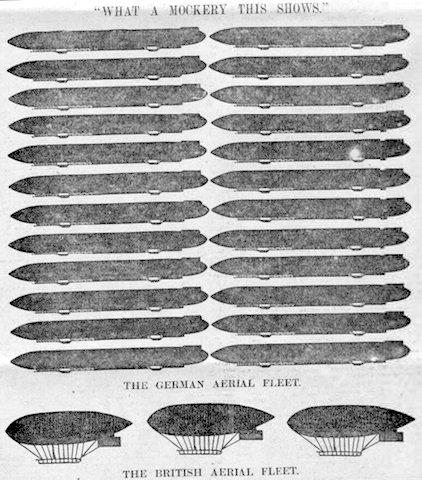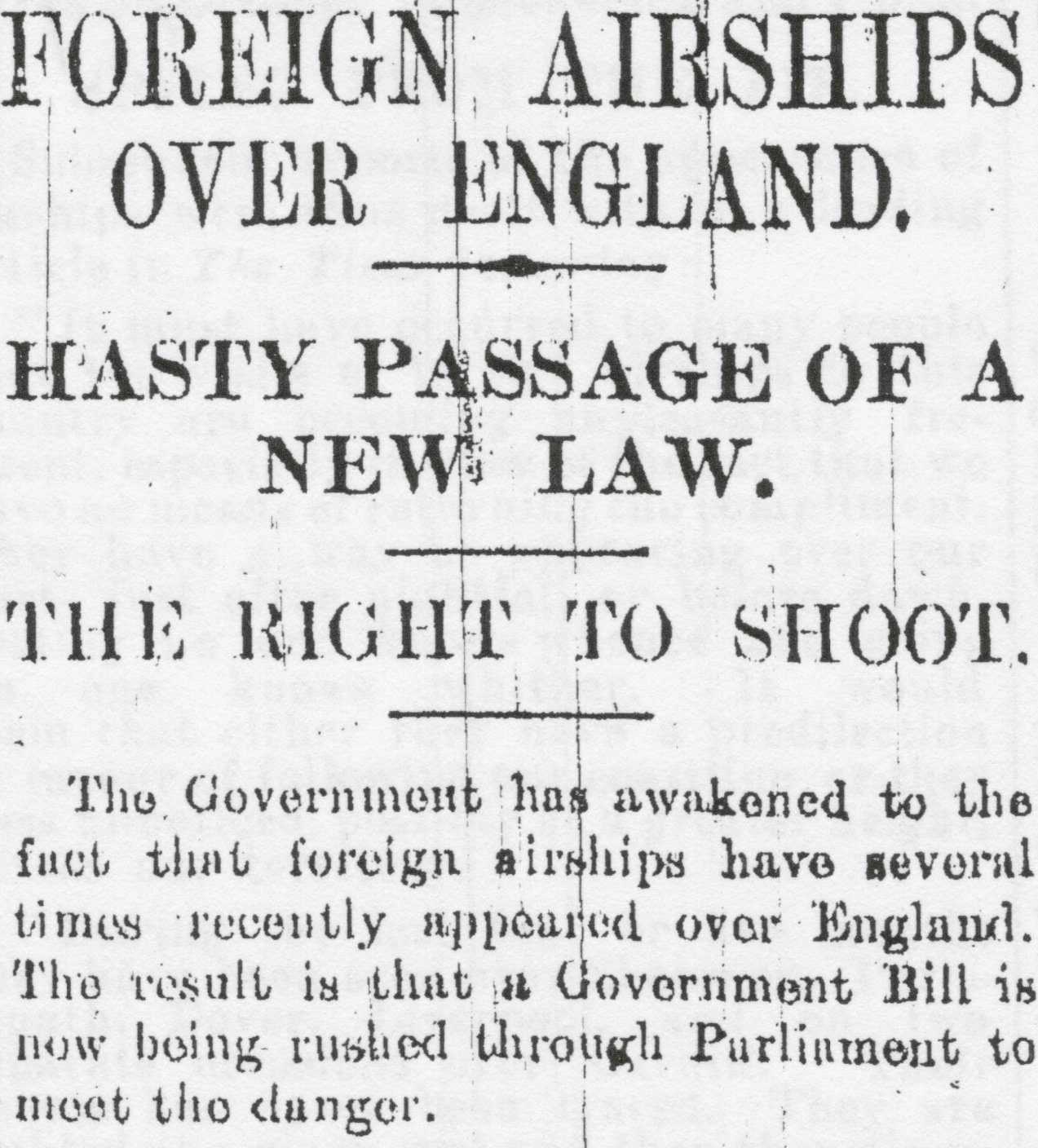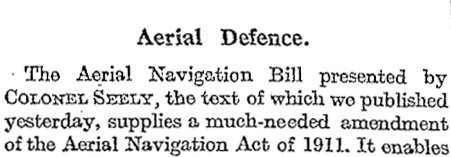
The Daily Mail carries a bare list of the last few days’ phantom airship sightings with few details, some of which are discussed more fully elsewhere in today’s (or yesterday’s) papers, but some are not:
Avonmouth, Bristol, yesterday evening [26 February 1913].
Hull and Grimsby, Tuesday night [25 February 1913].
Dover, Tuesday, 9.20 p.m.
Castle Donnington [sic], Derbyshire, Tuesday, 9.50 p.m.
Leeds, Tuesday night.
Portishead, Somerset, Tuesday, 8 p.m.
Ipswich, Monday night [24 February 1913].
Portsmouth, Monday night.
Withernsea, Yorkshire, Monday, 9.30 p.m.
Corbridge-on-Tyne, Saturday, 9.30 p.m [22 February 1913].
Selby, Scarborough, and Bridlington, Friday night [21 February 1913].
On the previously-reported Hull sighting on Tuesday night, the Daily Mail says that the Admiralty has confirmed that ‘None of the three airships possessed by our own military authorities was out that night, nor was the Willows airship belonging to the Navy’. (p. 5). According to the Standard (p. 9; above),
The airship whose lights were seen by crowds at Hull was first traced from the Humber by the crew of the steam trawler Bermuda, who watched its bright white light pass towards the town, descend and rise again, until it disappeared in the direction of Hull. The fisherman reported the occurrence immediately on entering port, and having been on the fishing ground for some time were unaware of similar mysterious airship visits in various parts of the country.
Also, further witnesses to the Gosport (or Portsmouth) airship have come forward, including
Constables Jenkins and Boyers, of the Hants Constabulary, who were on patrol duty. A sergeant of the Marines on duty at the barracks gate declares that he could make out dimly the body of a dirigible of considerable size. The object, whatever it was, came from a northerly direction, and finally disappeared towards the north-east.
The Western Times notes that in addition to the Ipswich airship being seen, ‘the throb of its engines was heard […] it was believed the airship was returning from the direction of Portsmouth to an unknown base’ (p. 4).
Of the new sightings, the most widely-reported one is from Portishead in Somerset, nearly all identical to this report from the Dublin Freeman’s Journal (p. 7):
James Case, caretaker of the recently dismantled battery at Portishead, on the Somerset Coast, yesterday reported to the military authorities at Bristol that whilst in his absence his wife was locking the gate on Tuesday night [25 February 1913] at about 8 o’clock she was startled by a strong light of bluish colour, which she believed to be from an airship. The light travelled slowly in a westerly direction. No Bristol biplane was flying at the time.
The Daily Express says that ‘Several people in Plymouth declare the distinctly saw the outline of a great shadowy shape circling over the town in the dusk on Tuesday night [25 February 1913]’ (p. 1); the Standard places this near Bovisand Bay (p. 9). The Daily Mirror‘s Aberdovey correspondent wired to report that (p. 4):
Large airship flashing searchlight passed over Carnarvon Castle in direction Liverpool Tuesday night [25 February 1913]. Great excitement among superstitious country-folk.
Coincidentally (or not), according to The Times an airship was actually seen in Liverpool that same night (p 6):
A resident in the neighbourhood of the Old Swan tramway terminus stated yesterday that he saw a bright light in the sky on Tuesday night [25 February 1913]. The supposed aircraft was seen from 8.15 to 9 p.m., and disappeared in the direction of Seaforth. The observers declare that they distinctly heard the throbbing of a motor and the whirring of a propeller. When first noticed the vessel was at a great height, and its light was taken for that of an exceptionally bright star. This assumption was, however, completely dispelled when later the form of the vessel could be seen. It circled over the district at a great speed before finally heading away towards the north end of the city.
The Derby Daily Telegraph, apparently drawing on another newspaper’s report, says that ‘The latest place’ where the mystery airship has been seen (p. 2)
is Castle Donington, where we are told on Tuesday night it created quite a respectable commotion. Three persons are said to have discerned it — a lady and two military officers — and how many more there are who did likewise it is impossible, of course, to say. It was half-past nine when the officers noticed a strange bright light in the sky. It was on the move, and though naught else could be descried, and no sound detected, ‘the only conclusion they could arrive at was that it was an airship. Suddenly there came a flash from the same direction, suggestive of a motor sparking, which lit up the heavens for a second. The light hovered over the valley of the Trent for a time, and finally disappeared in the direction of Chellaston. The nature of the manœuvres led the officers to conclude that observations were being taken of the Midland Railway, which is a means of communication between Aldershot, Salisbury, and the Eastern Counties.’ […] we are told that a number of Boy Scouts who were in some meadows, also observed a light in the sky at the time stated. ‘They climbed on to the top of an outbuilding in order to be able to see better and they add that at one period all the fields around were lighted up.’
And in North Devon, according to the Western Times (p. 4):
An airship passed over Ilfracombe about 9.30 on Tuesday, and was seen from the centre of the town by several people. Its light was plainly visible. It passed over the town, and made across the Channel towards Swansea.
In a separate article, the Western Times recalls when, ‘some years since at the time of a somewhat similar scare, the good people of Ilfracombe were one night greatly perturbed’ — and what caused it:
A mysterious airship was reported hovering over the town. It had, so the report ran, come across from the direction of the Welsh coast Ultimately all fears were allayed by the discovery that the light supposed to be attached to an airship, was in reality a lamp tied to a kite.
Such sceptical asides are increasingly common. For example, the Derby Daily Telegraph‘s article on the Castle Donington incident quoted above is actually laced with sarcasm, and has its own historical example of non-aircraft being mistaken for aircraft, when (p. 2)
it was announced that Cody was about to fly from London to Manchester for one of the big prizes. Hundreds, we might almost say thousands, of Derby people turned out to see him, and a very respectable proportion of them were quite satisfied that they saw him passing over the town. One worthy Boniface actually stepped into Osmaston-road with a powerful pair of glasses, and solemnly declared that he could not only see the aviator but could actually hear the throbbing of the engines. We have always thought those must have been the most powerful glasses ever manufactured because they not only assisted sight but also stimulated hearing. It turned out, however, to have been merely Mars after all — or was it Venus?
The Daily Mirror is again in the vanguard of the sceptics, asking (p. 4)
What on earth — or, perhaps, it should be in the air — is the matter with ordinarily sane and unimaginative English folk all over the country just now?
A fair proportion do not seem to be able to go out at night without seeing the lights of a phantom airship in the sky.
North, east, west and south, this ghostly and ubiquitous visitant is watched with open mouths and scared eyes.
But what does it all mean? What is the explanation of the strange mystery of this goblin airship? Does it really exist, or is a figment of an excited imagination?
Most likely the latter, according to a ‘professor of psychology of European reputation’ who spoke to the Daily Chronicle (says the Liverpool Echo, p. 7):
a great many people who vow they have seen this airship have probably been victims of an illusion. One man says he sees an airship, and by straining the eyes and auditory senses his friends can easily be persuaded that they also see it, and even hear the sound of the engines.
One ‘enthusiastic airship expert’ interviewed by the Daily Mirror argues that ‘had there been a German airship flying over England, it could not have avoided being seen by daylight’, and this alone ‘disproves beyond a shadow of a doubt the silly and hysterical stories of so-called “witnesses”‘ (p. 4). It also calls on Harry Harper, ‘joint author with Mr. Grahame-White of “The Aeroplane, Past, Present and Future”‘ to recount his investigations of two incidents during ‘the last airship scare‘:
I was able to discover definitely that Case No. 1 was the trick of a sportive motor-car firm, which towed a model dirigible balloon, bearing the inevitable light, behind a motor-car along a country road.
Case No. 2 was the effort of four practical jokers, who sent an ordinary fire balloon over a town on a Saturday night with a light hanging from it, and effectually ‘scared’ the whole community, which had already developed a mild attack of ‘airshipitis’.
The Liverpool Echo provides a rundown of some of the theories making the rounds (p. 7):
In the City, according to a London financial authority, the mystery airship is nothing more than a cute advertisement for a new aviation company.
Elsewhere the wonderful romances of invasion by aerial Dreadnoughts are treated as the prelude to a big scare campaign designed to force the Government into huge orders for dirigibles.
In other quarters again the visions are spoken of as hallucinations or as mistakes due to the remarkable brilliance of Venus in the heavens, or to glimpses of double stars or of seeing stars double.
Venus is probably the most common of the sceptical explanations. The Manchester Guardian, in the course of a detailed critique of the airship theory, points out that ‘the lights have usually been seen in the western sky about the time when the planet Venus, now very bright, is sinking towards that horizon’ (p. 7). A letter by William Porthouse of Manchester makes the point more strongly, claiming that ‘the so-called “mysterious airship” is nothing more nor less than the planet Venus approaching greatest easterly elongation, when it must of necessity appear in the western sky as an extraordinarily brilliant object’ (p. 8). He says that ‘I gave expression to these opinions at a public meeting a few weeks ago, and as a result I confirmed then the opinion I had formed a long time before, that a very small percentage of people indeed are acquainted with the apparent diurnal movement of the heavens, due, of course, to the actual axial rotation of the earth’. (This seems more than likely.) The Mirror asked W. C. Jenkins, ‘astronomer-curator in charge of the Godlee Observatory of the Manchester School of Technology‘ for an opinion, and he declared that ‘It is Venus without a shadow of a doubt’ (p. 4).
However, for every expert there is an equal but opposite expert, and the Liverpool Echo‘s expert is Dr Norman Lockyer, ‘the eminent astronomer’ (p. 7):
‘If it is true that an airship — foreign or English — is prowling in the air at night, and that certain people are ready to swear to having seen it, I can’t understand how others can say that this same airship is a star,’ he said to a representative last night.
Lockyer (and his father, Sir Norman Lockyer) actually hedges his bets, advising ‘those who see the phenomenon next time to watch it very carefully’ and see if the lights can be seen in the same direction for the next few nights and whether they disappear to the west or the east (not Venus, if the latter). But he thinks that ‘the night is by far the best time for flying in dirigibles’:
‘I daresay,’ he continued, ‘that an airship is actually scouring the land every night. The temperature is more equable at night, and the air is not liable to such changes in expansion or contraction as in the daytime. But again, I say, I cannot conceive how it could be mistaken for a star!’
The Standard also reacts against the astronomical theory (p. 9):
The Rev. H. P. Slade, of Hull, told a representative that he could not let pass unchallenged the view that the light seen was purely a natural occurrence in the sidereal heavens. He asserted that no one qualified to observe anything intelligently would mistake the coruscations of Venus for an airship. Colour does not enter into the light of the star, and he added: ‘I am frankly puzzled.’
Among those newspapers still holding to the German theory are the Daily Herald, the Irish Times, the Standard, and of course the Manchester Courier, which has put together yet another imaginative graphic to illustrate the airship menace (p. 7):

But most of the scaremongers do seem to be distancing themselves somewhat from the scareships. Even the Courier adds to its paragraph on the Portishead sighting the following note:
Many lights which have been reported as belonging to airships have been confused with the searchlights of battleships.
And as the Daily Mail says, ‘The very multiplicity of these reports discredits them’ (p. 5). Major B. Baden-Powell’s letter to The Times today probably expresses the semi-detached position of much of the conservative press quite well (p. 6):
While, in default of more convincing evidence, there is no reason to be alarmed at the vague reports of mysterious airships hovering over the country at night, yet such stories draw attention to a matter of the utmost importance to this country […]
Which is to say, there is very much a reason to be alarmed:
What if one fine night it were discovered that a dozen enormous hostile airships were floating over London, or Portsmouth or other centre [sic]? We might, after an hour or two, send a few aeroplanes to attack these airships, but, apart from their anti-aeroplane defence, they might be accompanied by a screen of their own aeroplanes, more numerous than all we could bring to bear. One old dirigible we might have wrecked, but a dozen of the new type would not be easy to knock out before they could accomplish their objective. It may be said that bomb-dropping is uncertain and by no means as effective as some may think. One or two, or even a dozen, bombs may do but little damage, but if 12 airships each launched some 50 large bombs, there would be a salvo such as must, to say the least, prove very disconcerting to the nerves of us poor wretches below. And this would not be all. After the detonation of some 600 powerful bombs in one night, next night or the night after, the enemy might return and ‘go on doing it’ every day that the wind allowed. We could do nothing to prevent them! Even if such tactics have not that decisive result that we have been accustomed to consider as necessary to defeat, yet, could we put up with such a bombardment day after day without soon coming to terms?
For what it’s worth, The Times‘s Berlin correspondent reports that ‘In German official quarters it is stated most emphatically that the mysterious aerial apparitions in England cannot possibly have proceeded from Germany’.
Further mentions of phantom airships may be found today in the Cornishman, Dundee Courier, the Evening Telegraph, the Exeter Gazette, the Irish Independent, and the Globe.
![]() This work is licensed under a Creative Commons Attribution-NonCommercial-NoDerivatives 4.0 International License.
Permissions beyond the scope of this license may be available at http://airminded.org/copyright/.
This work is licensed under a Creative Commons Attribution-NonCommercial-NoDerivatives 4.0 International License.
Permissions beyond the scope of this license may be available at http://airminded.org/copyright/.






Pingback: Friday, 28 February 1913
Pingback: Thursday, 6 March 1913
Pingback: Sunday, 2 March 1913